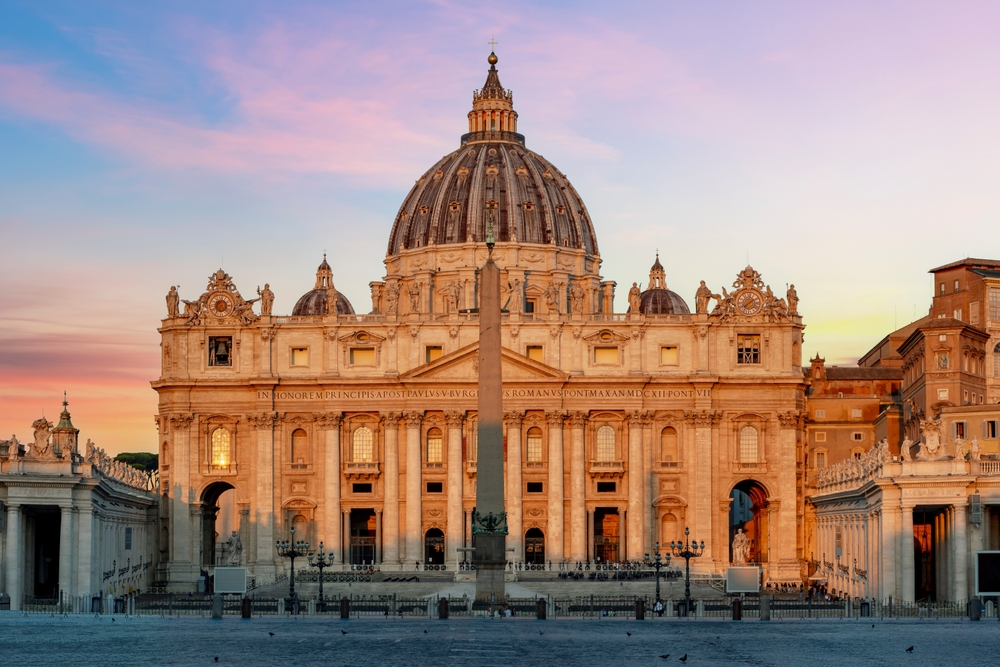St. Peter's Basilica, located in Vatican City, is one of the largest and most famous churches in the world. A symbol of faith, history, and artistic brilliance, this magnificent basilica stands as a testament to Renaissance and Baroque architecture.
It has been a central site of pilgrimage, with a history that stretches back to the 15th century, and is said to be the burial site of Saint Peter, the apostle and first Bishop of Rome.
Whether you are drawn by its religious significance, artistic treasures, or historical importance, St. Peter’s Basilica offers an unforgettable experience. In this guide, you’ll find practical tips on tickets, how to get there, opening hours, and a detailed exploration of the history and artistic features of this majestic basilica.
Important Information: Entrance to St. Peter’s Basilica is free, but tickets are required for some areas, such as the Dome and Treasury Museum.
Tickets for St. Peter's Basilica
Entrance to St. Peter’s Basilica is generally free, but tickets are required for areas like the Dome, the Treasury Museum, and for guided tours. To skip the long queues or gain access to special sections, we recommend booking a tour in advance.
Below are some of the best options:
Suggestion: For visitors opting to explore for free, expect long queues with wait times of several hours. Guided tours offer priority access and expert commentary.

Things to Do in St. Peter’s Basilica
Inside St. Peter’s Basilica, you’ll find some of the most iconic works of art and architectural marvels that have defined Christian art and architecture for centuries. Here’s what to look out for:
- Michelangelo’s Pietà: This marble sculpture, depicting the Virgin Mary cradling the body of Christ, is one of Michelangelo’s most revered masterpieces.
- St. Peter’s Baldachin: Designed by Gian Lorenzo Bernini, this massive bronze canopy stands over the High Altar and symbolizes the grandeur of the basilica.
- The Dome: The basilica's dome, designed by Michelangelo, offers panoramic views of Rome and Vatican City. It’s a must-see for visitors willing to climb the stairs or take the elevator partway up.
- St. Peter’s Chair: Encased within Bernini’s Cathedra Petri, this ancient wooden chair is believed to have been used by St. Peter and symbolizes the authority of the papacy.
- The Vatican Grottoes: Beneath the basilica lies the Vatican Grottoes, which house the tombs of several popes and offer a glimpse into the spiritual legacy of the Catholic Church.
Where Is St. Peter’s Basilica Located?
St. Peter’s Basilica is located in Vatican City, an independent city-state enclaved within Rome, Italy. It sits on Vatican Hill, near the Tiber River, and is easily accessible by public transportation or on foot.
- Address: Piazza San Pietro, 00120 Città del Vaticano
- Google Maps: St. Peter's Basilica Location
How to Get There
Public transport options include:
- Metro Line A: Ottaviano station (13-minute walk)
- Bus Routes: 34, 46, 62, 64, 98, 881, 916, 916F (Cavalleggeri/S. Pietro stop, 8-minute walk)
- By Guided Tour: Choose a guided tour for expert insights and a deeper exploration of St. Peter’s Basilica.
You can find official Public Transport Maps via this link.
Opening Hours of St. Peter’s Basilica
Knowing the opening hours can help you plan your visit efficiently. Here's what you need to know:
- Basilica: Daily from 7:00 am to 7:10 pm
- Dome:
- Summer (April 1 to September 30): 7:30 am to 6:00 pm
- Winter (October 1 to March 31): 7:30 am to 5:00 pm
- Grottoes: Daily from 9:00 am to 6:00 pm
Note: During periods of high visitor volume, closures may occur 30 minutes earlier than scheduled, depending on queue length.

History of St. Peter’s Basilica
St. Peter's Basilica has a rich and multifaceted history. Tradition holds that it is built over the burial site of Saint Peter, one of Jesus' apostles and the first Bishop of Rome.
The original Old St. Peter’s Basilica, commissioned by Emperor Constantine in the 4th century, stood on this site until it fell into disrepair.
In the 15th century, Pope Nicholas V began the process of rebuilding. Construction officially started on April 18, 1506, under Pope Julius II, with renowned architects such as Michelangelo, Bramante, and Bernini contributing to the project.
It was completed on November 18, 1626, making St. Peter’s a masterpiece of Renaissance and Baroque architecture.
Today, St. Peter's Basilica serves as a major pilgrimage site and is central to many important papal ceremonies.
What is the Basilica of St. Peter now?
Today, St. Peter's Basilica is not only an active place of worship, but also a major tourist destination.
It hosts important liturgical events, including papal masses and is a focal point for pilgrims and visitors from all over the world.
The basilica remains a symbol of Catholicism and is home to some of the most iconic works of religious art.
Architectural Features of St. Peter's Basilica
The architecture of St. Peter’s Basilica is an awe-inspiring blend of Renaissance and Baroque styles. Key architectural highlights include:
- The Dome: Designed by Michelangelo, this massive dome dominates the Vatican skyline and is an engineering marvel.
- The Facade: Created by Carlo Maderno, the grand Corinthian columns and central balcony are a prelude to the basilica's majestic interior.
- The Nave: Spanning 211 meters, the nave leads worshippers towards the High Altar, surrounded by towering marble columns.
- The Baldachin: Designed by Bernini, this bronze canopy is a striking Baroque masterpiece towering over the papal altar.
Interior Design and Michelangelo’s Artwork of St. Peter's Basilica
Michelangelo’s influence is evident throughout the basilica.
His Pietà sculpture, one of his most renowned works, is housed here, along with his design for the dome, which serves as a defining feature of the basilica’s architecture.
The interior design is characterized by grand mosaics, marble floors, and intricate detailing that highlight the artistic and spiritual beauty of the space.
Why Should You Visit St. Peter’s Basilica?
Visiting St. Peter’s Basilica is an opportunity to experience a blend of art, history, and spirituality.
Whether you’re exploring Michelangelo’s masterpieces, standing beneath the dome, or attending a religious service, a visit here offers a profound connection to centuries of faith and artistic achievement.
It’s a must-see for anyone interested in history, religion, or architecture.
Facilities and Accessibilities of St. Peter’s Basilica?
St. Peter’s Basilica provides several facilities to ensure a smooth visit:
- Restrooms: Located throughout the basilica grounds.
- Cloakroom: Available for storing large bags and items.
- Gift Shops: Purchase souvenirs and books related to the basilica.
- Accessibility: Wheelchair access is available via ramps, and sign language tours can be arranged.
Visiting Rules for St. Peter’s Basilica
To ensure a respectful and enjoyable experience, visitors should follow these rules:
- Dress Code: Shoulders and knees must be covered.
- Silence: Visitors should maintain a respectful and quiet demeanor inside.
- Bag Policy: Large bags must be stored in the cloakroom.
- Photography: Flash photography is prohibited to protect the artworks.
Traveler Tips for St. Peter’s Basilica
Important Information: It is very crucial to buy your tickets in advance. It is very difficult to find tickets due to the high demand of people.
If you want to buy during your trip, you may not be able to find tickets.
Visiting St. Peter’s Basilica is a memorable experience. To make the most of your trip, here are some helpful tips:
- Book Tickets in Advance: Skip the long lines by securing your tickets online for a hassle-free entry.
- Arrive Early: Get there early to enjoy the basilica's beauty without the heavy crowds.
- Take a Guided Tour: Enrich your visit with a guided tour for deeper insights and access to hidden areas.
- Use an Audio Guide: Explore at your own pace while learning about the basilica's history with an audio guide.
- Dress Modestly: Ensure your shoulders and knees are covered out of respect for this sacred site.
- Stay Hydrated: Bring a bottle of water, especially in warmer months.
- Climb the Dome: Don't miss the chance to ascend to the dome for stunning views of Vatican City and Rome.
- Respect Artifacts: Handle everything with care and avoid touching the historic artwork.
- Beware of Pickpockets: Stay alert and keep your valuables safe in crowded areas.
- Watch for Scams: Be cautious around Castel Sant'Angelo—avoid buying unwanted items or services.
- Explore Nearby Attractions: Extend your visit to nearby sites like the Vatican Museums, Sistine Chapel, and Vatican Gardens for a fuller Vatican experience.

Top Attractions Near St. Peter’s Basilica
Extend your visit to St. Peter’s Basilica by exploring nearby attractions:
- Museum Leonardo Da Vinci Experience: 0.25 mile / 400 m, 6-minute walk
- Vatican Museums: 0.6 mile / 1 km, 13-minute walk
- Castel Sant'Angelo: 0.6 mile / 1 km, 13-minute walk
- Piazza Navona: 0.9 mile / 1.5 km, 21-minute walk
- Pantheon: 1.2 mile / 1.9 km, 27-minute walk
St. Peter’s Basilica is a symbol of faith, beauty, and artistic mastery. From its iconic dome to the masterpieces housed within, it continues to inspire millions of visitors each year. Whether you come to admire its artistic treasures or experience a moment of spiritual reflection, St. Peter’s Basilica stands as a monument to the divine and the enduring spirit of humanity.

